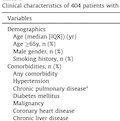Abstract
Objective
The risk factors and the impact of NAI treatments in patients with severe influenza A-associated pneumonia remain unclear.
Methods
A multicenter, retrospective, observational study was conducted in Zhejiang, China during a severe influenza epidemic in August 2017-May 2018. Clinical records of patients (>14 y) hospitalized with laboratory-confirmed influenza A virus infection and who developed severe pneumonia were compared to those with mild-to-moderate pneumonia. Risk factors related to pneumonia severity and effects of NAI treatments (monotherapy and combination of peramivir and oseltamivir) were analyzed.
Results
202 patients with influenza A-associated severe pneumonia were enrolled, of whom 84 (41.6%) had died. Male gender (OR = 1.782; 95% CI: 1.089-2.917; P = 0.022), chronic pulmonary disease (OR = 2.581; 95% CI: 1.447-4.603; P = 0.001) and diabetes mellitus (OR = 2.042; 95% CI: 1.135-3.673; P = 0.017) were risk factors related to influenza A pneumonia severity. In cox proportional hazards model, severe pneumonia patients treated with double dose oseltamivir (300mg/d) had a better survival rate compared to those receiving a single dose (150 mg/d) (HR = 0.475; 95%CI: 0.254-0.887; P = 0.019). However, different doses of peramivir (300 mg/d vs. 600 mg/d) and combination therapy (oseltamivir-peramivir vs. monotherapy) showed no differences in 60-day mortality (P = 0.392 and P = 0.658, respectively).
Conclusions
Patients with male gender, chronic pulmonary disease, or diabetes mellitus were at high risk of developing severe pneumonia after influenza A infection. Double dose oseltamivir might be considered in treating influenza A-associated severe pneumonia.
